Review articles. Рубрика в журнале - International Journal of Cognitive Research in Science, Engineering and Education
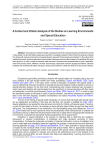
A content and citation analysis of the studies on learning environments and special education
Статья обзорная
This study aims to review the studies on learning environments and special education and determine the trends in these studies. Content and citation analysis were used which is a qualitative research method. Data of the study were collected from Scopus with ‘learning environment’ and ‘special education’ keywords 180 documents were collected. For the analysis of the published documents, previously determined content analysis criteria were used and citation analysis of the published documents were carried out, in order to reveal the frequently cited documents. Documents were examined based on year of publication, name of the journals, authors, affiliations, countries, document type, subject area, keywords, language and citations. Data were presented and interpreted with tables and figures. Results were presented in detail with reference to the previous literature.
Бесплатно
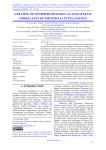
A review of neurophysiological and genetic correlates of emotional intelligence
Статья обзорная
The article is an overview of modern studies of brain organization and genetic correlates of emotional intelligence. Emotional intelligence is becoming the subject of more and more attentive study of psychologists due to the fact that it influences the mental development of humans, plays an important role in many professions, and its impairment is a marker of some disorders. Nevertheless, the brain organization and genetic correlates of emotional intelligence have not been studied enough - first studies appeared only in the early 2000s. A review of the literature on the enceph-alographic showed that in rest, people with higher emotional intelligence show greater excitation of the left anterior regions of the brain. When per-ceiving affective stimuli, participants with high emotional intelligence show stronger synchronization of some EEG rhythms. Brain mapping technique made it possible to identify the areas of the brain involved in activities related to emotional intelligence. In regard to genetic correlates of emotional intelligence, some genes of neurotransmitter systems have been associated to this trait: the catechol-O-methyltransferase gene COMT, the dopamine DRD2 receptor gene, the serotonin receptor gene HTR2A, and the BDNF brain neurotrophic factor gene.
Бесплатно
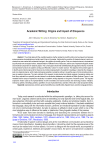
Academic Writing: Origins and Impact of Eloquence
Статья научная
The article deals with the unsettled question whether academic scientific writing can be eloquent and possess some expressive characteristics and what impact it has on the reader. Historically the evolution of classical science to post-non-classical one was marked with substantial changes in the stylistics of scientific genres. Post-non-classical science is characterized by profoundly new conceptual notions, interpenetration of different forms of discourse, and the use of expressive linguistic means and emotional components in research papers. The current paper shows that notwithstanding the apparent antinomy, the formal and expressive functions of academic writing can effectively “coexist” in modern science. The objective of the present paper is to identify socio-historical grounds for tolerance to emotional representation of academic knowledge, to describe the changes in post-non-classical science, which made emotiveness possible in academic writing, to reveal the ways of communicating emotiveness in academic discourse. The main methods of this research include textual and stylistic analysis of academic articles and their titles, selected from scientific journals indexed in authoritative databases and materials of British National Corpus. It was revealed that the scope of expressive vocabulary in academic writing depends on the genre of scientific prose. The linguistic expressive means used by the representatives of both humanities and natural sciences and technology include: metaphor, metonymy, epithets, intensifying adverbs, quantifiers, the use of precedent texts, assertion of the author’s style and gender identity.
Бесплатно
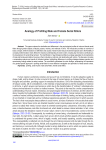
Analogy of Profiling Male and Female Serial Killers
Статья научная
This paper explores the similarities and differences in the psychological profiles of male and female serial killers through gender aspects, analyzing causes, motives, and methods of crime. The introduction provides an overview of basic concepts, while the sections on definitions and causes of serial murder discuss incoherent aspects due to the flexibility of conceptual determination which affects the empirical understanding of serial murder, including key risk factors contributing to the development of serial killing behavior. The identification of psychological profiles by analogy separates the characteristics of male and female serial killers, focusing on their motivations, methods, and relationships with victims. The discussion includes a comparative analysis and results of individual studies, highlighting differences in profiling strategies between genders and summarizing findings related to serial murders. The conclusion synthesizes the main findings, emphasizing the importance of a gender-specific approach in profiling serial killers for more effective investigation and prevention of these severe crimes.
Бесплатно
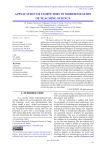
Application of computers in modernization of teaching science
Статья обзорная
The basic tendency of this paper is to point to the increasing application of information technology in teaching, and therefore also in the teaching of science and society. This means that educational process is constantly developing and improving, but teaching aids also are modernizing. Modern didactic and methodical knowledge are increasingly pointing out the shortcomings of traditional teaching and they offer solutions for overcoming these drawbacks, among the others, and through the modern informational technologies. In this sense, the use of computers is not just something that is recommended but it is becoming more necessary since it is the path to the active acquisition of knowledge and creativity. Multimedia teaching resources, contents and educational computer software enable students to critically use knowledge sources, to independently learn, analyze, systematize, compare and explore. The advantages offered by informational technologies are also in the fact that the teacher is relieved from one part of the obligation, teaching type, so it leaves him more time for the design of the teaching process. Purposefully use of teaching aids and forms of work, takes into account the capabilities of each student. The use of the computers and educational software in teaching provides a better flow of information since the presentation of information is performed through the multiple senses, so students can receive them visually or acoustically. Temporarily use of modern teaching aids (computers, educational software, etc.) allows students to come up quickly with different information and thus fulfill not only their increased interest in a particular area but also gain new knowledge.
Бесплатно
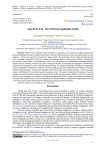
Can AI be Evil: The Criminal Capacities of ANI
Статья научная
Artificial Narrow Intelligence (ANI) represents a captivating domain within technological advancement, bearing the potential for profound societal transformations. While ANI holds the promise of enhancing various facets of human existence, it concurrently engenders inquiries into its “darker aspects.” This study delves into the challenges associated with ANI’s conceivable manifestation of harm and injustice, a phenomenon devoid of consciousness, intention, or responsibility akin to that of human entities. A pivotal dimension of ANI’s “dark side” pertains to its susceptibility to malevolent utilization. Despite its lack of awareness, ANI serves as a tool for malicious endeavors, encompassing the propagation of disinformation, compromise of security systems, and consequential decision-making. This prompts contemplation on strategies to mitigate these “precise manifestations of malevolence” arising from ANI’s technological progression. Additionally, ANI’s development introduces profound ethical quandaries. Ensuring ANI’s alignment with moral principles while averting scenarios in which it generates decisions conflicting with human morality becomes a pressing concern. This research underscores the imperative for rigorous regulatory frameworks and ethical directives to curtail potential hazards and unscrupulous utilization of ANI. The fundamental objective of this investigation is to advocate for the responsible deployment of ANI in society. A comprehensive understanding of potential risks, complemented by meticulous consideration of ethical dimensions, emerges as an indispensable prerequisite to harmonizing technological advancement with safeguarding societal and individual interests.
Бесплатно
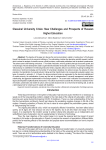
Classical university crisis: new challenges and prospects of Russian higher education
Статья обзорная
The objective of the paper is to discuss the most crucial problem, related to “winding down” of the Russian Liberal Arts education due to its economic inefficiency. The methodology includes the descriptive scientific-research method, which involves the analysis of scientific sources, official provisions, mass-media publications and the students' questionnaire. The authors came to the following conclusions: 1. The model of education, which is guided by the logic of economic growth, and not by the logic of human development, leads to a general dehumanization of education and society. 2. The process of education “dehumanizing” is manifested in the following destructive trends: pragmatic utility and convenience of gaining knowledge; the dominance of technical knowledge and the transfer of humanitarian disciplines into optional courses; the advance of online education; the imperfection of university lecturers' ratings and their transformation into a bureaucratic evaluation system; new types of inequality in education. 3. In Russia, the above-mentioned trends are aggravated by the abnormal establishment of market economy; the verticalization of power and the lack of professionalism in university management; social sphere underfunding; the aggressive implementation of the Bologna system. 4. The current crisis in education is accompanied by the large-scale emigration of gifted students and lecturers. The authors recommend to consider the University as a classical “home” of formation, preservation and transfer of culture; online courses should be seen as a new format of teaching aids, as well as a technological tool for retraining and for people with disabilities.
Бесплатно
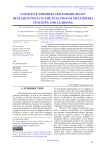
Статья обзорная
At present it is almost impossible to imagine formal and non-formal education without the use of computers and information and communication technology (ICT), and we can rightly say that modern education is increasingly taking place in a multimedia environment and relying on multimedia teaching and learning. In fact, multimedia with its existence and progress continually poses new challenges to educational technology, but also to the teaching process itself. As a result, classical traditional learning and teaching leaves classrooms, while parallel to that, multimedia becomes an unavoidable segment in the process of acquiring knowledge. The multimedia display provides a better understanding and understanding of teaching content that can be presented in many ways, and which gives a higher educational value. The focus of work is the importance and contribution of the theory of multimedia learning with a focus on activating cognition among students, as well as an analysis of the effectiveness of the use of media in teaching. Also, a special emphasis in the work is focused on the analysis of qualitative and quantitative research methods and techniques for examining the role, significance and efficiency of multimedia teaching and learning in the educational process.
Бесплатно
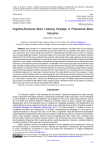
Cognitive-emotional music listening paradigm in professional music education
Статья обзорная
Music education is an important factor of students’ development. The positive effect of music training is evident in all areas, from the intellectual, psychomotor to social and emotional ones, and therefore music classes in the music school should focus both on music making and on experience, understanding and evaluating music, as well as on expressing one’s own ideas, feelings and thoughts. In ear training classes it can be achieved through the area of music listening. Didactical initiatives of the 19th and 20th century contributed to the recognition of the advantages of the auditory approach, while technological innovations allowed the practical application of music listening. Although there are examples that point to fostering the emotional experience in music classes, music listening is still focused on giving assignments of cognitive type and learning about music components. Some exceptions pertain to the application of multimodality in music teaching using both musical and extra-musical areas. The paper is aimed at pointing to the value of the cognitive-emotional music listening and to the possibilities it opens in ear training classes. The cognitive-emotional music listening focuses on experiencing, understanding and appreciation of classical music aimed at shaping students’ worldview and improving their music competences. It can be achieved by the multimodal and interdisciplinary approach to a musical piece. Students learn about the musical-historical context of the emergence of a piece in a given time and circumstances, about the composing approach and the theoretical and harmony features of the work, they develop their musical and critical thinking, make music, and evaluate both music and their own achievements. Repeated listening to a musical piece or excerpts from it, observing and familiarizing with the piece from different perspectives and discussion about the piece and experience after listening make it possible to better understand the piece and its specifics, as well as to discover and improve one’s own self and accept others and the different.
Бесплатно
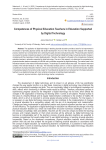
Competences of physical education teachers in education supported by digital technology
Статья обзорная
The application of digital technology in teaching physical education provides a basis for its improvement in the direction of promoting physical activity and student development. As one of the most important subjects of the teaching process, teachers have a fundamental role in achieving the goals and tasks of physical education. Physical education teachers are required to develop competences based on which they would implement digital technology in physical education classes in compliance with the imperatives of modern digital education. Therefore, this research is focused on the competences of physical education teachers in education supported by digital technology. The aim of this research is to determine the competences of physical education teachers necessary to fulfil their role in education supported by digital technology. The method used in this theoretical research is the method of theoretical analysis. The technique of content analysis was used. The research instrument consists of the relevant literature on this topic. The theoretical analysis points to a need to expand and improve the digital competences of physical education teachers, which can be achieved by joint action of formal and informal education systems in developing programs that would provide a basis for the professional development and empowerment of physical education teachers to use digital technology with more certainty and purpose in teaching physical education.
Бесплатно
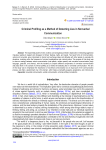
Criminal Profiling as a Method of Detecting Lies in Nonverbal Communication
Статья научная
The exponential growth of crime, violence, and wrongdoing is linked to dysfunction in restraining aggressive impulses, leading to neglect and disrespect of others’ feelings, rights, and needs. Two basic forms of communication, verbal and nonverbal, serve individuals to interact and exchange ideas and attitudes with other people in everyday life situations, including within the framework of criminal investigations and criminal justice. The purpose of this study was to draw an analogy between verbal communication (oral speech, written speech) and nonverbal communication (body language, gestures, and silence), with the tendency to explore different components of nonverbal communication and place them in the context of criminal profiling as a method for detecting lies in nonverbal communication. The aim of this study was to emphasize the importance of nonverbal communication as an equal part of the communication process, and often a predominant one in this domain, which helps us demystify suspects, perpetrators, and criminal acts.
Бесплатно
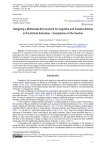
Статья обзорная
This article focuses on the formation of pedagogical competence for the design of multimodal educational environment, the functionality of which is the foundation of the cognitive and creative activity of the child in pre-school age. It problematizes the need for adequate professional reflection of the teacher in the context of the transgressive approach and highlights the parameters of organizing pedagogical interactions that utilize multimodality as a communication phenomenon. The understanding that the competence of the teacher for designing a multimodal environment as well as cognitive and creative activities develops as transgressive and is continuously created in the cultivation of new knowledge and skills, while expanding the cognitive and practical limits of the subject, is affirmed. Based on this affirmation, the thesis that if a child has entered the “communicative state” and has engaged in multimodal educational interactions, the child appropriates the social experience by forming a transgressive attitude of behavioral response.
Бесплатно
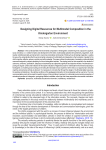
Designing digital resources for multimodal composition in the kindergarten environment
Статья обзорная
In the contextual field of environmental composition in kindergarten, transforming it into a space for cognitive, social, emotional, i.e., holistic formation and development of the child, multimodality operates with authenticity, magnetism, multilevelity, multidimensionality, and dynamism to overcome schematicity and linearity of thinking, thus stimulating imagination. Leading the way is the understanding that the environmental composing of multimodality in kindergarten is the foundation of quality for the child’s cognitive, affective, sensory cognition and self-knowledge. This paper outlines the parameters of evaluating multimodal digital resources designed by students preparing for future kindergarten teachers. The starting points for their expertise in the relations of autonomy, coherence, justification, adequacy and authenticity as subjectively significant and objective wholes of multimodal composing are argued. Criteria and indicators for the expert evaluation of digital resources for multimodal environmental composing in kindergarten, as modeling and provoking and enriching the individual sensory experience of the child, as an opportunity to stimulate cognitive and personal activity are derived. It is necessary to conclude that through the design of multimodal digital resources, the existing contradictions in the starting conditions of the pedagogical interaction in the kindergarten will be overcome. The main recommendation points to the need for specific training of future children’s teachers for multimodal environmental composition of educational practices in kindergarten, synergizing different modalities, rather than their linear sequential environmental combination.
Бесплатно
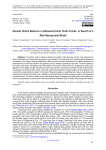
Deviant online behavior in adolescent and youth circles: in search of a risk assessment model
Статья обзорная
The authors made an attempt to describe the problem of developing the concept of risk assessment of deviant online behavior of minors and young adults in social networks. The article looks into the psychological consequences of banalizing of the internet, analysis possibilities for offline and online behavior. Approaches for risk factors assessment of deviant behavior in real life are described: the qualitative (clinical), statistical (actuarial) and structured. The article systemizes the studies of risk factors, vulnerability, and deviant patterns in the context of phenomena such as aggressive, asocial, auto-aggressive, self-mutilating, suicidal, risk-taking and victim online behavior. Approaches and models of online deviant behavior are discussed; an attempt is made to build a structured model of risk assessment of deviant patterns of online behavior in the context of the cultural historical concept. On the basis of theoretical analysis, a hypothetical set of group, interindividual and intraindividual constructs is formulated, the combination of online and offline risk factors produces a model for risk assessment of deviant behavior. The article is written as part of the research project “Developing the profiling model of online behavior of minors and young adults in social networks” which was initiated by the Moscow State University of Psychology and Education.
Бесплатно
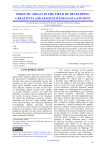
Didactic skills in the field of developing creativity and innovativeness of a student
Статья обзорная
The authoress of this article highlights the areas of mutual connections and dependencies between theory and practice of students’ creative development, making at the same time an attempt to show creativity against the background of didactic competence of a teacher. She describes the discussed creativity in the teachers’ attitude primarily as an incessant search for better didactic solutions, discovering new learning opportunities and challenging the hitherto accepted assumptions of working with students. She points out that the leading trait of the teacher’s creativity is also the ability to look for different ways of solving the same problem. In this article creative educational initiatives are analysed as well, they are perceived as a chance of creating more effective methods for a teacher to work with his or her students and facilitate their development and growth on many creative levels.
Бесплатно
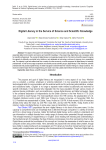
Digital Literacy in the Service of Science and Scientific Knowledge
Статья научная
The subject of this paper is the interdependence of communication and digital literacy, as original entities, and especially digital communication and science and scientific knowledge. In the present day, digital literacy is a necessary ability for scientific professionals. The concept of digital literacy is increasingly prevalent in the 21st century. Scientific research requires the capacity to efficiently use digital tools, platforms, and databases as technology continues to improve at an unparalleled rate. The capacity to get and assess data from a variety of online sources is a crucial component of digital literacy for scientific professionals. In order to encourage cooperation and creativity across scientific groups, digital literacy is vital. Moreover, scientific professionals that possess digital literacy are better equipped to disseminate their research findings to a larger audience. The essence is that the higher the level of digital literacy, the easier it is to find suitable and therefore the best forms of communication.
Бесплатно
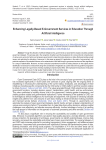
Enhancing Legally-Based E-Government Services in Education Through Artificial Intelligence
Статья научная
Through the utilization of artificial intelligence (AI), governments can automate the analysis of publicly available government datasets. This process aids in the recognition of patterns and the development of a more profound comprehension of various socio-economic factors and empowers governments to base their policy decisions on data, effectively tackling societal issues, and optimizing the allocation of resources. In this paper we present AI’s application in the realm of e-government, with particular emphasis on its potential influence on the advancement of this field through e-government services and their significance for a range of stakeholders. Moreover, we have conducted comprehensive review of existing literature on the subject and the identification of avenues for enhancement along with consideration of legislation as a potent instrument to guide the progression of AI within the sphere of e-government, thereby amplifying its transformative effect. We emphasize the importance of education in area of AI in order to ensure it’s high quality implementation in this and other areas.
Бесплатно
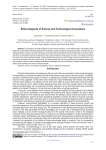
Ethical aspects of science and technological innovations
Статья обзорная
The progress of civilization depends on both science and ethics, on two different ideas. Unlike ethics, which deals with moral principles and ideals that guide human behavior, science is based on logical argumentation, empirical data, and methodical testing. However, as science develops, it often raises ethical questions that must be addressed. As a result, science and ethics are intertwined and both are essential for the moral and long-term advancement of science. This research examines the results of two interconnected processes: the quick development of science and technology and its moral ramifications, or the harm it does to people’s lives all around the world. The writers highlight the need for a qualitative shift in attitudes toward nature and society as a whole in order to address environmental challenges and remove the threat of a global ecological disaster by analyzing the substance and impact of these processes.
Бесплатно
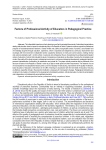
Factors of professional activity of educators in pedagogical practice
Статья обзорная
The indisputable importance of early learning as well as the accepted documents of international organizations dealing with education have an impact on educational policy in the Republic of Serbia. Systemic solutions support the professional progress of educators/preschool teachers. Clearly limited and publicly recognizable areas of practice, accumulated fund of knowledge acquired through education, experience, which is expanded and deepened by continuous improvement and exchange with the environment; independent and/or cooperative decisions on timely and correct actions; meeting internal and external standards (self / control); ethics in personal and professional life are characterized by professional/competent actions of educators. Factors that modulate the level of competence of educators are the status of society, the immediate social context, the quality of the study program, professional environment, continuous professional development, pedagogical practice, personal characteristics of educators, job satisfaction and private life. The paper critically examines the key elements of the structure of factors in the Republic of Serbia in order to put light on weak points and their improvement. The research of a set of macrosystemic and subsystemic factors points out to the necessity of restructuring, improvement of the quality of selection, basic education of educators, interventions in the offer of trainings in accordance with the real needs of educators. Ensuring an effective, respectful climate in the preschool institution is necessary for microsystem changes. Pedagogical implications are contained in the creation of conditions for the development of participatory relations, critical observation, but also the emancipation and independence of professionally accomplished educators.
Бесплатно
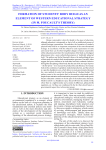
Статья обзорная
Human corporeality is directly related to the space of education, although education is interpreted as, first of all, an intellectual process of cultural heritage transmission. Nevertheless, the formation of student's physical body build is an important component of the state educational strategy. In accordance with the objectives and requirements of state and society there can be observed global changes in human corporeality within educational activities: the transformation of the body as a biological phenomenon into a socio-cultural phenomenon or “politically subjected body”. The authors use Michel Foucault's ideas as the methodological base of their study of a student's body transformation processes. Foucault's ideas suggest that power influences an individual and their authentic behavior through the disciplining of their body, that the aim of the new type of power - the bio-power - is to increase the productivity and efficiency of a human body in the conditions of capitalistic industrial production, and that school is a specific disciplinary area, which allows to meet governmental demand for a new method of control via the production of “obedient bodies”. The authors come to the conclusion that in the modern educational model, despite democratization and humanization processes Foucault's trends persist because education continues to be the part of the technocratic discourse. Modern school is a disciplinary space fenced off from the outside world, where there is a rigid hierarchy and a system of differences, physical drill, regulation, etc. All these are conditioned by the fact that school honors a governmental request for a technocratic person.
Бесплатно

